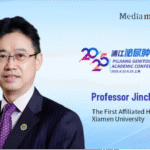
Editor’s Note: The 13th Ludaopei Hematology Academic Conference, jointly organized by the Beijing Health Promotion Association and the Guangzhou Hongmian Tumor and Rare Disease Public Welfare Foundation and hosted by the Beijing Ludaopei Institute of Hematology, was held in Beijing on August 22–23, 2025. The conference brought together leading hematology experts from around the world to focus on hematopoietic stem cell transplantation, cellular therapy, and precision management of hematologic malignancies, delivering a high-level, in-depth academic program for more than a thousand attendees. During the meeting, Professor Robert Negrin—ASH President-Elect and Chief of the Division of Hematology and Blood and Marrow Transplantation at Stanford University—presented a lecture entitled “Immunoregulatory Mechanisms to Improve Transplant Outcomes.” Hematology Frontier invited Professor Negrin to address core clinical questions, with the aim of providing practical guidance and theoretical reference for optimizing transplant management.
PART.1
Hematology Frontier: In allogeneic hematopoietic stem cell transplantation, inducing or infusing regulatory T cells (Tregs) can significantly reduce the risk of GVHD. In real-world practice, how do you weigh the options between exogenous Treg supplementation and in vivo selective expansion (for example, low-dose IL-2 or engineered IL-2) to achieve immune tolerance while preserving the graft-versus-leukemia (GvL) effect? What evidence best informs clinical decision-making at this stage?
Professor Robert Negrin: The central issue is how to harness regulatory T cells in clinical applications. Multiple strategies are under active investigation. A fundamental challenge is that we do not yet have a drug that selectively expands Tregs. Because Tregs resemble conventional T cells in many respects, agents designed to activate or expand Tregs often expand conventional T cells as well. Interleukin-2 (IL-2), for example, is an attractive candidate but also affects other immune populations.
The data I presented focus on isolating Tregs and transferring them as a purified cell population. This is not the only way to achieve biological effects, but it is a direct strategy with validated preclinical support. Ultimately, what matters is which approach yields the best clinical outcomes—something only carefully designed clinical trials can determine. Current evidence lays the groundwork for one approach, and other strategies can build on it in pursuit of superior efficacy. The imperative is to move these concepts into clinical practice.
PART.2
Hematology Frontier: Engineered CAR-Tregs and antigen-specific Treg engineering are entering clinical trials (for example, CAR-Tregs against HLA or graft antigens). How feasible do you find CAR-Tregs for inducing tolerance in organ and hematopoietic transplantation? What safety or manufacturing issues concern you most as these move into the clinic?
Professor Robert Negrin: Investigators are developing several approaches to enhance Treg activity, including introducing chimeric antigen receptors (CARs) or isolating antigen-specific Tregs. One concept we have explored is to engineer a novel receptor that responds only to particular forms of IL-2—so-called “orthogonal IL-2”—thereby selectively boosting the function of cells expressing that orthogonal IL-2 receptor. Each of these strategies has strengths, and we hope completed studies will continue to confirm the biological functionality of Tregs while we refine their performance.From a safety standpoint, I am not overly concerned, given our extensive experience with multiple cellular therapies. The more critical question is which method delivers the best efficacy. Personally, I favor strategies that stimulate and expand Tregs in vivo. Whether achieved through CARs or orthogonal IL-2 receptors, both avenues are promising.
That said, to introduce a novel receptor into a CAR-T cell requires ex vivo manipulation: harvesting cells, activating them, and transducing them with a vector. This may alter their biological properties. It is therefore essential to confirm that manipulated CAR-T cells retain the key functions of their parental cells. As these approaches move into clinical trials, this issue must be addressed rigorously.
PART.3
Hematology Frontier: Beyond Tregs, recent work has explored innate populations such as NKT cells and combined immunoregulatory strategies to promote “infectious tolerance.” In your view, which combinations are most promising for reducing GVHD/rejection while preserving antitumor activity? In what models or early clinical data are these combinations most convincing?
Professor Robert Negrin: I am particularly encouraged by the Treg data, as this work has advanced to randomized trials—an indication of genuine clinical translation. Research on invariant natural killer T cells is scientifically compelling, but their extreme rarity in vivo creates significant technical barriers to isolating sufficient numbers for clinical use. These challenges reflect both biology and current technological limits.
While these studies are scientifically important, their ultimate value must be proven in clinical trials, a process that is time-consuming and demanding. My hope is that the data presented today will spur deeper investigation by demonstrating feasibility and potential for positive clinical outcomes. The priority now is to use this foundation to optimize strategies and continually improve clinical applicability and efficacy.


